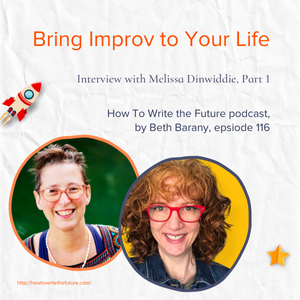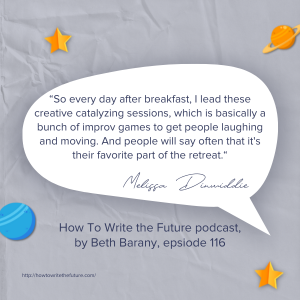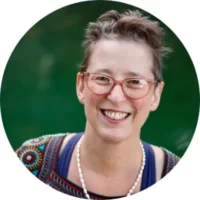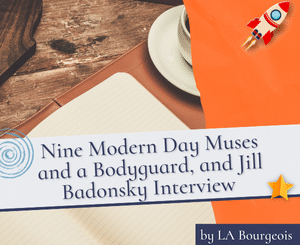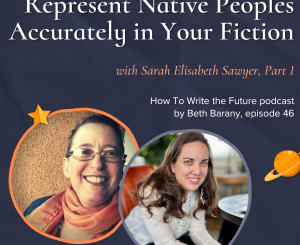Bring Improv to Your Life, Interview with Melissa Dinwiddie, Part 1
Bring Improv to Your Life, Interview with Melissa Dinwiddie, Part 1 – How To Write the Future podcast, episode 116
“So every day after breakfast, I lead these creative catalyzing sessions, which is basically a bunch of improv games to get people laughing and moving. And people will say often that it’s their favorite part of the retreat.“ —Melissa Dinwiddie
In this latest How To Write the Future episode, “Bring Improv to Your Life, Interview with Melissa Dinwiddie, Part 1”host Beth Barany interviews former professional artist and trained improviser, Melissa Dinwiddie, who shares her personal journey about how she became an artist after believing she was not creative and how it changed her identity. And together they discuss her book, The Creative Sandbox Way.
Platforms The podcast is available on Apple Podcasts | Buzzsprout | Spotify | Podcast Addict | Amazon Music | Youtube
RESOURCES
Free World Building Workbook for Fiction Writers: https://writersfunzone.com/blog/world-building-resources/
Sign up for the 30-minute Story Success Clinic with Beth Barany: https://writersfunzone.com/blog/story-success-clinic/
Get support for your fiction writing by a novelist and writing teacher and coach. Schedule an exploratory call here and see if Beth can support you today: https://writersfunzone.com/blog/discovery-call/
About Melissa Dinwiddie

A former professional artist and trained improviser and jazz singer, Melissa Dinwiddie helps senior tech leaders increase their influence and reduce conflict by helping their teams communicate and connect better so their work has impact across the organization, all through her F.U.N. Method™. She designs interactive, playful programs that attendees rave about because they acquire new skills and behaviors and build connections while having a blast. Her book, The Creative Sandbox Way™, has been called “essential for the bookshelf,” “the owner’s guide for the caring and feeding of the creative spirit,” and “an adventure packaged as a book.”
https://creativesandbox.solutions/
Instagram: https://www.instagram.com/a_creative_life/
LinkedIn: https://www.linkedin.com/in/melissadinwiddie/
Ready to harness the power of improv to take your leaders and HiPo’s to the next level? Evaluate where your team stands with Melissa’s Leadership Assessment Tool 👉https://bit.ly/LeadershipAssessmentTool
About the How To Write the Future podcast
The *How To Write The Future* podcast is for science fiction and fantasy writers who want to write positive futures and successfully bring those stories out into the marketplace. Hosted by Beth Barany, science fiction novelist and creativity coach for writers. We cover tips for fiction writers. This podcast is for readers too if you’re at all curious about the future of humanity.
This podcast is for you if you have questions like:
– How do I create a believable world for my science fiction story?
– How do I figure out what’s not working if my story feels flat?
– How do I make my story more interesting and alive?
This podcast is for readers too if you’re at all curious about the future of humanity.
Transcript for episode 116 – Bring Improv to Your Life, Interview with Melissa Dinwiddie, Part 1
I’m your host, Beth Barany. I am an award-winning science fiction and fantasy novelist, writing teacher, creativity coach, and I run this podcast because I believe with science fiction and fantasy stories, we can reshape the world. And my focus is on positive, optimistic stories because what we vision, what we actually envision in our stories, we can help make so in the world.
[00:25] BETH BARANY: So I am very excited today to bring a special guest to you, Melissa Dinwiddie.
Melissa, welcome. I’m so excited to have you here.
[00:33] MELISSA DINWIDDIE: Thanks for having me, Beth. I’m so excited to be here.
[00:00:37] BETH BARANY: So everyone gets to know who you are, Melissa, I’m gonna read this awesome bio that you sent me and then we’ll get diving into your wonderful questions.
[00:44] About Melissa Dinwiddie
BETH BARANY: Melissa Dinwiddie is a former professional artist and trained improviser and jazz singer. She helps senior tech leaders increase their influence and reduce conflict by helping their teams communicate and connect better, so their work has impact across the organization all through her FUN method. And she designs interactive, playful programs that attendees rave about because they acquire new skills and behaviors and build connections while having a blast.
Her book, The Creative Sandbox Way, has been called essential for the bookshelf, the owner’s guide for the caring and feeding of the creative spirit and an adventure packaged as a book.
I love that. Now I have to read your book.
Oh, so glad that you’re here. And it’d be great to share a little bit about your journey.
So can you tell us a little bit about how did you go from the arts to corporate training?
[01:40] How Melissa Became An Artist
MELISSA DINWIDDIE: Absolutely. And first I, because your listeners are creatives, I wanna share a little bit about how I became an artist, because that’s an really important part of the journey as well, because I know a lot of creators, creatives, tend to wrestle with, issues around doubt, self-doubt, self-criticism. I know I did.
And my story is I spent many years really believing that I was not creative. And I fell backwards into becoming an artist. And I never expected to be an artist. When I was a teenager, I stopped making art and I stopped making music, and I stopped doing all the creative things because I got really caught in the comparison trap really badly.
I now call it my 15-year hiatus as a, as an artist. And I came back to it in my late twenties. I did dive into dance in my teens and really like head first, dove into dance, and that was my identity. I was gonna become a professional dancer and then I got injured. And that was the end of that.
Although I spent five years on the quest for the miracle cure. Anyway, I ended up getting into academia and got a bachelor’s degree and went on and got a master’s degree, thinking I was gonna go get a PhD and realized that was not the right path for me.
So now what do I do? And I ended up getting engaged to the man who is now my ex-husband.
But at the time I didn’t know he was gonna be my ex-husband. We planned this wedding. And, now I can look back and see I was pouring all this creative energy into planning this wedding, and it happened to be a Jewish wedding because we are both Jewish, although I wasn’t raised with- I didn’t go to a synagogue or anything.
I didn’t have a bat mitzvah, but we had a Jewish wedding. And we hired a ketubah artist to make this beautiful document, which is part of every Jewish wedding ceremony called the ketubah. And after we got married, we interviewed several different artists. This was like the big thing that we put a lot of money into was this ketubah that felt very important to us.
The ketubah was like- after the wedding, we’re gonna put it on the wall. So we interviewed several artists and the, the first person that we interviewed incorporated a lot of paper cutting or parchment cutting as she was working on parchment in her work.
And I just was very fascinated with this particular medium and we didn’t end up going with that artist ’cause she was expensive. We ended up going with another artist who actually was a much better artist, a much better calligrapher. And I loved her ketubah, but I just felt after the wedding was over, I didn’t have, now I can look back and see, I didn’t have all this like creativity be to be, I didn’t have an outlet to be pouring all my creativity into and I felt this lack of that.
And now I can only identify it as I felt this lack of paper cutting in my life.
[04:42] “What do I want to do with my life?”
MELISSA DINWIDDIE: I was trying to, figuring out like what do I wanna do with my life. I thought, maybe, I dunno, I’ll get into publishing or something. And then I thought, actually it’s writing that I’m really interested in.
I always wrote. I always got good grades on all my essays in college and grad school.
I’ll be a writer. But as every time I tried to write, great works of genius didn’t just flow instantaneously from my fingertips. I would sit at my little Mac computer and feel like I must really suck at this thing because it was excruciating.
Because I had all this pressure on myself to produce all of a sudden. And so I started procrastinating and one of the ways in which I procrastinated was I started doing arts and crafts, but I didn’t think of it as art at the time. I was just playing around. And I started making paper cuts and I used an Exacto blade. Or I don’t even know what I used at the beginning. But I finally went to the art store and I bought actual supplies, feeling like a total fraud.
[05:45] Fell backwards into becoming an artist – it changed my identity
MELISSA DINWIDDIE: And that’s what led me into starting to play around with making art. And that sort of fell backwards into becoming an artist, starting with paper cuts and then learning how to do calligraphy and eventually becoming a ketubah artist myself.
To make a long story a little bit shorter, I ended up becoming a professional calligrapher and ketubah artist for 15 years, which was amazing at first. And it felt like the first time I got paid to make art , it changed my identity of myself as a creative, I felt so emboldened and empowered. But very quickly, within a year or a year and a half or two, I started to feel very. I don’t know repressed. And it changed my relationship with my creativity fairly quickly.
And then especially after I was married to that man for about four and a half years. And then we got divorced and suddenly I had to really fish or cut bait. I either go get a job or I’m gonna really make this creative thing that I’m doing, pay the bills, which it had been paying for my classes and my conferences and my supplies, and it had been paying for itself, but it hadn’t been paying the bills.
And so suddenly there was a lot of pressure on my creativity to pay for everything, which now I felt like everything I made had to be amazing. And it had to bring in money. I felt like I no longer had time to create for joy, to create for exploration, to create for fun.
[07:24] My procrastination device
[07:24] MELISSA DINWIDDIE: And that’s what had gotten me into it in the first place. It had been my procrastination device from the writing. So now I needed a new procrastination device because now art had become just a job. So that’s what I did for 15 years.
And cut to 2010, I was completely burned out. I really hated being a ketubah artist and being a professional artist. It’s like the holy grail for so many people, right? And I was miserable. The universe walloped me upside the head a few times in a row with some personal and professional things that got me face down in the gutter.
And I realized, oh, I don’t have to do this. I don’t have to just be a ketubah artist for the rest of my life. I can choose what I wanna do. What do I wanna do? I wanna live a creative life. What does that look like? And I spent a number of months figuring that out. And guess what I started to do?
[08:19] Living a creative life blog
MELISSA DINWIDDIE: I started writing. Wow. I started writing on a blog. I called it Living a Creative Life. And I just was writing to process. Yeah. I wasn’t writing to make money. I wasn’t writing to impress anybody. I was writing to figure out what this creative life was that I wanted to live. And all of a sudden I, through the process of processing, I discovered that I actually loved to write.
It wasn’t that I sucked at writing. At the time, I thought it was just the wrong medium of writing, the wrong genre of writing. Now, I realize it wasn’t even that. It was simply that I had this pressure on myself to be amazing and make a living and get things in magazines or whatever.
From there, I started selling little online courses and things like that and built up a business helping other people get creatively unstuck. I realized, I figured out at a certain point that I had to get back to creating, making art for the joy of it, just for pure joy.
[09:19] I’d forgotten how to play
[09:19] MELISSA DINWIDDIE: I had forgotten how to play. Yeah. ’cause all the 15 years of making art for other people, I’d forgotten how to play and I had to figure out how to get back to that place. And so my book, The Creative Sandbox Way, is all about these 10 guideposts that I developed. I call them little rules that I created for myself – that mind space of being a little kid, like a 4-year-old playing around in a sandbox like, gee, what would happen if I do this? What would happen if I do that? That’s what kids are doing when they’re playing, messing around with markers or literally playing in a sandbox, right? They’re not thinking about, is this gonna make money? Is this gonna get a blue ribbon? Whatever. They’re not thinking those things.
So how do I trick myself in order to get back into that place?
[10:03] Tricked myself with rules or guideposts
MELISSA DINWIDDIE: The way that I tricked myself was I came up with four little rules ’cause I’m a great rule follower. Over time, it expanded into 10, which I call them guideposts ’cause most artists don’t like rules.
And what I discovered was that what worked for me worked for other people as well. So over a number of years, those guidepost rules, what I was writing about on my blog and turning into little online courses and things like that worked for other people. So I built up this online business.
[10:35] Again falling backwards into business but…
MELISSA DINWIDDIE: Again, I fell backwards into a business. But then, not long before the pandemic. I realized this online business thing is really not where my strengths are. What am I doing?
In the meantime, building this online business to help people get creatively unstuck, which was very nourishing to me.
I love making that kind of impact- was incredibly nourishing, but my favorite part of it was running these in-person retreats, which I only did once a year.
[11:07] Improv for workshops
MELISSA DINWIDDIE: I had meanwhile started doing improv, taking improv classes and going through the whole sequence of classes at all the local schools and performing improv. And so I would bring these improv activities into my retreats. I didn’t refer to them as we’re now going to do improv. I would say: after breakfast every morning, we’re gonna have a creative catalyzing session to get everybody out of your heads and into your bodies because the gremlins live in your heads.
[11:38] The gremlins in your head
MELISSA DINWIDDIE: Here’s a couple of gremlins. These little guys, they’re like, you suck. What do you think you’re doing? You can’t write for shit, whatever.
[11:47] BETH BARANY: Love those gremlins.
[11:49] MELISSA DINWIDDIE: Yeah, because that’s what all those negative voices, right? The critical voices, the self-doubting voices, they live in your head. And when we can get out of our heads and into our bodies and laughing and moving. Then we can send those gremlins off to get a pedicure. And then we can get down to the work of our creative thing and dive into that uncertainty, which is where we have to be in order to be creative.
[12:16] Creative catalyzing sessions or improv games for teams
MELISSA DINWIDDIE: So every day after breakfast, I lead these creative catalyzing sessions, which is basically a bunch of improv games to get people laughing and moving. And people will say often that it’s their favorite part of the retreat.
So number of years of this, I found myself thinking, wow, this is exactly the same thing that I would be doing with a business team.
A team of leaders, a team of executives, a team of engineers, a team of who knows, it could be any team. I would be leading them through the exact same activities. I would just be debriefing it differently depending on what skills they need to work on, or whatever issues they’re needing to solve for.
[13:01] The big pivot
MELISSA DINWIDDIE: So why don’t I pivot and start a consultancy and make an impact in that world where they actually have money to pay me. And it took me a while to make that shift because I had to deal with the gremlins in my head that said, you can’t do that. You don’t have any experience in corporate.
So it did take a while, since I didn’t have a network. I didn’t come from that world. It was like starting at the base of Mount Everest and climbing up that learning how to sell into big companies and all of that has been a big, huge shift. ’cause selling B2C is totally different from selling B2B.
As an individual into big companies is just a completely different landscape. And I’ve had to learn that. Anyway, so I was just starting to get a little bit of traction and then this little thing happened called the Global Pandemic. And here I was like, oh, I’m doing everything in person now. What am I doing with this online business?
I’m shifting everything to in person. And then this global pandemic happened and then, I thought, now what am I gonna do? But then I looked around and realized, a lot of people are really struggling with what to do on Zoom, and that’s something that I can help with.
So I spent about three years not only doing virtual sessions but also helping people do zoom better, basically.
So I did a lot of curriculum design for different organizations, helping them do virtual instructor-led trainings, designing them, training their staff to lead them. I did a lot of work inside of Facebook, helping them train research managers on how to communicate for influence using improv tools all virtually.
Yeah, so that’s the story. I know that was kinda long.
[14:57] The creative entrepreneur journey
BETH BARANY: I think it’s really great to hear your journey. I’ve been a creative entrepreneur now for 17 years and had such a ups and downs and all arounds and ended up working for myself. Okay, let’s just jump into the deep end working for myself and how do I do that? And so it’s great to hear your journey.
Creative writers who wanna build a career, that’s their own thing. It’s gonna look different for everybody.
And to hear your journey and how it’s not a straight path. And we don’t have it all laid out and we don’t have all the answers, five steps ahead.
[15:26] Trust the unknown
BETH BARANY: Sometimes it’s just, now what? And we figure it out, we jump in. And so I love hearing your story because you’re demonstrating how we have to trust the unknown, trust the creative process, trust what’s emerging, and it’s not predictable.
And it can be a little scary, a little off-putting sometimes, at least for me.
[15:43] The scary actions
BETH BARANY: Sometimes I’m like, what I wanna do what? I wanna make a movie?! Girl? I’ve been wanting to make a movie for like almost 17 years, and now I finally am. I am ready. I’m finally doing this thing.
[15:52] MELISSA DINWIDDIE: That’s awesome.
[15:53] BETH BARANY: Yeah, it’s a short film. It’s actually literally the teaser to a TV pilot. It’s a film and we’re gonna make the thing, and then after that, we’ll decide. We’ll figure out what’s next. I have the vision, but will it happen? I don’t know. We never know. This film I know, but the next one, I don’t know. The TV show? That would be cool.
[16:09] Constant Experimentation
MELISSA DINWIDDIE: Wow. You, what you just described is exactly my experience. Certainly as a business owner. It’s constant uncertainty. It’s constant experimentation. It’s constant- that didn’t work. Let’s try something else.
I’ve had to do a lot of mindset work. To de-, what’s the word? I have a tendency or I’ve had a tendency to pathologize and be like, oh, I just suck at this. I’m just a failure, or it’s my problem or something.
And it’s been really helpful to have good support to reframe and turn it around and help me see that, no, actually that is what it means to be in business.
That it’s just you try things and sometimes they work and sometimes they don’t.
And you go on social media and all is the highlight reels of everybody else.
So you think that everybody else is doing great, all the time. But in reality, everybody else is having the same situation. There’s ups and downs. And you look at famous people and how many famous billionaires do you know who’ve had multiple bankruptcies.
[17:24] “My first draft sucks”
[17:24] BETH BARANY: And failure. I see a lot of beginning writers coming to me so upset that their first drafts suck. And I’m like, yeah, that’s called a first draft. It’s meant to suck. Very few writers can write a really polished first draft. Even good writers have to go over their work and their first draft is not the same as their final draft. So we don’t demonstrate for the world the early versions, the mess ups.
[17:46] Dealing with failure
BETH BARANY: Oh yeah, I tried to launch that class. It didn’t work. I tried it this way, and oh, that took off. And that’s why we have this form of the business right now. Or the story idea came out this way, but I didn’t really like it, so everyone told me these ideas, and I tried it and I, oh yeah, that worked much better.
You don’t know. You don’t know until you try.
[18:03] Part 1 wrap up
BETH BARANY: That’s it for part one of my conversation with Melissa.
Stay tuned until the next episode where I have Melissa explain her F U N method.
Also in part two, we’re going to demonstrate her FUN method on me.
And then in part three, we will talk about how to write the future and tie that into her wonderful methods.
Be sure to check out my World Building Workbook for Fiction Writers, if you want to inject some fun and support into your world building for your science fiction and fantasy story.
That’s it for this week, everyone.
Write long and prosper.
Loved this episode? Leave us a review and rating here: https://www.buzzsprout.com/2012061
ABOUT BETH BARANY
Beth Barany teaches science fiction and fantasy novelists how to write, edit, and publish their books as a coach, teacher, consultant, and developmental editor. She’s an award-winning fantasy and science fiction novelist and runs the podcast, “How To Write The Future.”
Learn more about Beth Barany at these sites:
Author site / Coaching site / School of Fiction / Writer’s Fun Zone blog
CONNECT
Contact Beth: https://writersfunzone.com/blog/podcast/#tve-jump-185b4422580
Email: beth@bethbarany.com
LinkedIn: https://www.linkedin.com/in/bethbarany/
IG: https://www.instagram.com/bethbarany/
TT: https://www.tiktok.com/@bethbarany/
FB: https://www.facebook.com/bethbarany
X: https://twitter.com/BethBarany
CREDITS
- EDITED WITH DESCRIPT: https://www.descript.com?lmref=_w1WCA (Refer-a-Friend link)
- MUSIC CREDITS : Music from Uppbeat (free for Creators!): https://uppbeat.io/t/soundroll/fuzz-buzz License code: UMMKDRL02DFGKJ0L. “Fuzz buzz” by Soundroll. Commercial license: https://musicvine.com/track/soundroll/fuzz-buzz.
- DISTRIBUTED BY BUZZSPROUT: https://www.buzzsprout.com/?referrer_id=1994465 (Refer-a-Friend link)
- SHOW PRODUCTION BY Beth Barany
- SHOW CO-PRODUCTION + NOTES by Kerry-Ann McDade
C 2024 BETH BARANY
For more “How To Write the Future” episodes, go here.
If you’d like to invite Beth onto your podcast, drop her a note here.

